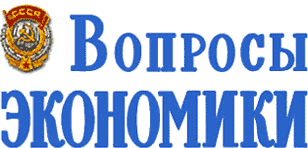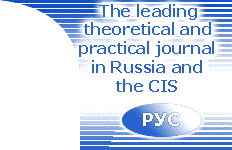NEW ECONOMY FOR NEW RUSSIA
|
|
PROBLEMS OF THE WORLD ECONOMY
|
|
THE POTENTIAL OF RUSSIAN BANKS
|
|
|
DEBATING-SOCIETY
|
|
__________________
- R. Nigmatulin - On Optimal Share of Government Expenditures in GDP and Rates of Economic Growth
|
IN AID TO THE LECTURER
|
|
Abstracts
|
|
Y. KUZNETSOV.
Transition to Knowledge-intensive Growth in Russia
|
|
The paper proposes a strategy to trigger knowledge-intensive growth based on a combination of bottom up and top down reforms. When both market and government failures are pervasive, institutional innovation (new ways of doing things and reach credible commitments) becomes paramount for growth and reform. The paper discusses entry points to trigger institutional innovation at a local level and proposes a mechanism of incremental self-reinforcing reform (bootstrapping). A three-stage approach to reform is proposed: top down reforms to enhance even playing field; a contest between regions to unleash institutional innovation; active federal industrial policy.

|
|
L. GOKHBERG.
Russian National Innovation System under Conditions
of the "New Economy"
|
|
The paper focuses on modernization of the Russian national innovation system under conditions of the emerging "new economy", determined by transformation of innovations, information technology and education into key factors of economic growth. Analysis of specifics of the S&T and innovation sector is provided from the viewpoint of its consistence with the requirements of the economy and society. Potential measures of its reforming are formulated, e.g. required institutional changes, reorganization of the public budget system, stimulation of technology commercialization and innovation activity.

|
|
V. KUDROV.
Contemporary World Economy and Russia
|
|
The author analyses the forecast of the world economy performance provided in the early 1970s by the UN group of experts under W. Leontief leadership and compares it with contemporary world economic indicators. The conclusion is that the forecast was too optimistic: the world economy didn't manage to reach the suggested rates of economic growth. Russia and other transition economies suffered of great recession in the 1990s but now are stepping on the path of economic growth based on integration in the globalized world economy. One of the main factors of achieving that goal is WTO accession.

|
|
V. GUELBRAS.
China: "A Bee Has a Stripy Back, but No One
Can Call It a Tiger"
|
|
The article is devoted to verification of the Chinese GDP data. The author compares the rates of GDP growth with the rates of growth of energy consumption, transport turnover of goods, and numbers of projected and constructed objects in 1980-2000. The former was significantly lower during that period. He also analyses the level of using productive capacities and the quality of production. About 25-30% of industrial productive capacities are not used because there is neither national nor international demand for their low quality goods. The main conclusion of the article is that the Chinese GDP real size is about 20-30% less than official releases.

|
|
S. MOISEEV.
The Dollar Marches around the World
|
|
A great debate is taking place in many countries of the American Continent and in Central and Eastern Europe on the need and benefits of abandoning the national currency in favor of the dollar. The paper analyzes the theories of the central banking and the official dollarization and looks into the perspectives of dollarization in Latin America.

|
|
A. SARKISYANTS.
The Role of Banks in the Economy
|
|
The article is devoted to the problems of the Russian banking sector and its ties with the real sector. It considers a new post-crisis model of the Russian banking system. Special attention is paid to public deposits as the main source of banks' passives.

|
|
L. BARON, T. ZAKHAROVA.
Disproportions between Вanking System and Non-financial
Sector Development in the Russian Economy
|
|
It's been shown that despite some improvements in the Russian banking sector, it's indicators have not achieved the pre-crisis level yet and can't be compared with similar indicators in other countries. Moreover, Russian banks' credit resources are insufficient if the growing tendency of exceeding outstanding credits' volume over corresponding banks' resources is taken into account. In the authors' opinion it can lead to incapability of the Russian banking system to satisfy the relevant credit demand of the non-financial corporate sector and cause a medium-term systemic banking crisis.

|
|
A. BUZGALIN.
Heuristic Potential of Political Economy of Socialism
in the 21st Century
|
|
The author tries to distinguish the main achievements of political economy of socialism, its contribution to modern economic theory and potential in analysis of post-industrial society. To his opinion political economy of socialism is useful for understanding the nature of "real socialism" (i.e. economic system that was really functioning in the USSR and socialist countries), future post-capitalist economic systems and transitional economy. Moreover, this discipline can be helpful in overcoming the market-oriented paradigm dominating now in economic theory.

|
|
R. NUREEV.
Public Choice Theory. A Textbook.
Chapter 8. Political Systems. Separation of Powers.
Problems of Federalism
|
|
Different political systems are considered in the eighth chapter of the textbook. The characteristics of democratic and authoritarian forms of government are described. The stability of democracy under presidential and parliamentary systems is analyzed. The advantages and disadvantages of separation of powers are distinguished. Factors of stability of federal state are characterized. The chapter also includes further readings, control tests and questions.

|



